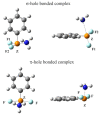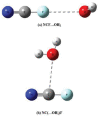Noncovalent Bonds through Sigma and Pi-Hole Located on the Same Molecule. Guiding Principles and Comparisons
- PMID: 33804617
- PMCID: PMC8003638
- DOI: 10.3390/molecules26061740
Noncovalent Bonds through Sigma and Pi-Hole Located on the Same Molecule. Guiding Principles and Comparisons
Abstract
Over the last years, scientific interest in noncovalent interactions based on the presence of electron-depleted regions called σ-holes or π-holes has markedly accelerated. Their high directionality and strength, comparable to hydrogen bonds, has been documented in many fields of modern chemistry. The current review gathers and digests recent results concerning these bonds, with a focus on those systems where both σ and π-holes are present on the same molecule. The underlying principles guiding the bonding in both sorts of interactions are discussed, and the trends that emerge from recent work offer a guide as to how one might design systems that allow multiple noncovalent bonds to occur simultaneously, or that prefer one bond type over another.
Keywords: chalcogen bond; cooperativity; halogen bond; molecular electrostatic potential; pnicogen bond; tetrel bond.
Conflict of interest statement
The authors declare no conflict of interest.
Figures









Similar articles
-
Dissection of the Origin of π-Holes and the Noncovalent Bonds in Which They Engage.J Phys Chem A. 2021 Aug 5;125(30):6514-6528. doi: 10.1021/acs.jpca.1c05431. Epub 2021 Jul 26. J Phys Chem A. 2021. PMID: 34310147
-
The pnicogen bond: its relation to hydrogen, halogen, and other noncovalent bonds.Acc Chem Res. 2013 Feb 19;46(2):280-8. doi: 10.1021/ar3001316. Epub 2012 Nov 7. Acc Chem Res. 2013. PMID: 23135342
-
Carbon-Bromide Bond Activation by Bidentate Halogen, Chalcogen, Pnicogen, and Tetrel Bonds.J Phys Chem A. 2024 Dec 12;128(49):10534-10543. doi: 10.1021/acs.jpca.4c06230. Epub 2024 Nov 25. J Phys Chem A. 2024. PMID: 39584752
-
Classification of So-Called Non-Covalent Interactions Based on VSEPR Model.Molecules. 2021 Aug 15;26(16):4939. doi: 10.3390/molecules26164939. Molecules. 2021. PMID: 34443526 Free PMC article. Review.
-
Non-classical Non-covalent σ-Hole Interactions in Protein Structure and Function: Concepts for Potential Protein Engineering Applications.Chem Asian J. 2023 Apr 3;18(7):e202300026. doi: 10.1002/asia.202300026. Epub 2023 Feb 24. Chem Asian J. 2023. PMID: 36764929 Review.
Cited by
-
Chalcogen Bond as a Factor Stabilizing Ligand Conformation in the Binding Pocket of Carbonic Anhydrase IX Receptor Mimic.Int J Mol Sci. 2022 Nov 8;23(22):13701. doi: 10.3390/ijms232213701. Int J Mol Sci. 2022. PMID: 36430173 Free PMC article.
-
Sensitivity of Intra- and Intermolecular Interactions of Benzo[h]quinoline from Car-Parrinello Molecular Dynamics and Electronic Structure Inspection.Int J Mol Sci. 2021 May 14;22(10):5220. doi: 10.3390/ijms22105220. Int J Mol Sci. 2021. PMID: 34069244 Free PMC article.
-
Reassessing the Role of σ Holes in Noncovalent Interactions: It is Pauli Repulsion that Counts.Front Chem. 2022 Apr 7;10:858946. doi: 10.3389/fchem.2022.858946. eCollection 2022. Front Chem. 2022. PMID: 35464203 Free PMC article.
-
Exploring the Dynamical Nature of Intermolecular Hydrogen Bonds in Benzamide, Quinoline and Benzoic Acid Derivatives.Molecules. 2022 Dec 13;27(24):8847. doi: 10.3390/molecules27248847. Molecules. 2022. PMID: 36557978 Free PMC article.
-
Halogen bonds, chalcogen bonds, pnictogen bonds, tetrel bonds and other σ-hole interactions: a snapshot of current progress.Acta Crystallogr C Struct Chem. 2023 Jun 1;79(Pt 6):204-216. doi: 10.1107/S2053229623004072. Epub 2023 May 22. Acta Crystallogr C Struct Chem. 2023. PMID: 37212787 Free PMC article.
References
-
- Guthrie F. On the Iodide of Iodammonium. J. Chem. Soc. 1863;16:239–244. doi: 10.1039/JS8631600239. - DOI
-
- Remsen I., Norris J.F. Action of the halogens on the methyl-amines. Am. Chem. J. 1896;18:90–96.
-
- Hope H., McCullough J.D. The crystal structure of the molecular complex of iodine with tetrahydroselenophene, C4H8Se.I2. Acta Cryst. 1964;17:712–718. doi: 10.1107/S0365110X64001773. - DOI
-
- Olie K., Mijlhoff F.C. The crystal structure of POBr3 and intermolecular bonding. Acta Cryst. Sect. B. 1969;25:974–977. doi: 10.1107/S056774086900327X. - DOI
Publication types
Grants and funding
LinkOut - more resources
Full Text Sources
Other Literature Sources
Research Materials
Miscellaneous

